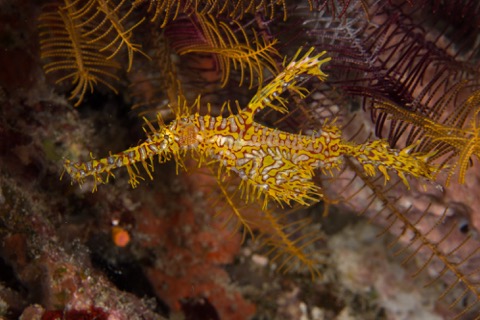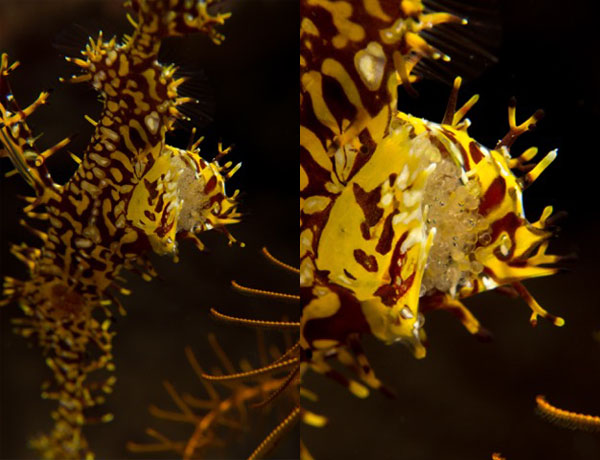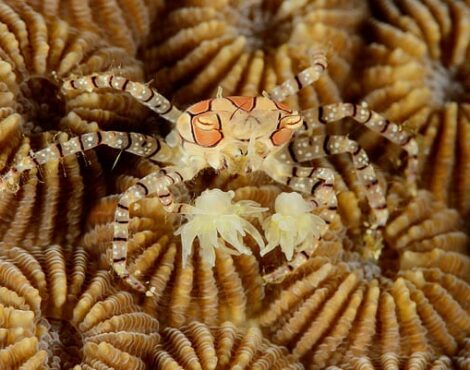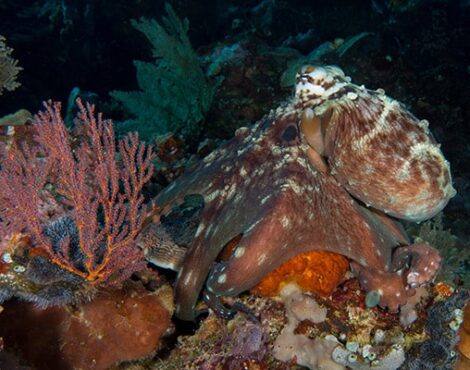Survival of the Camouflaged: Ghost Pipefish in the Marine Ecosystem

With a constant threat of predation, the marine ecosystem can be a tough one to thrive in. This has forced a number of creatures to either ‘evolve or die’. Ghost Pipefish have evolved some of the best camouflage out there, almost perfectly mimicking crinoids, algae and sea grass. Their disguise can be so good even an experienced spotter may have a hard time finding them, but with their unique shapes and colours, they are well worth the time spent searching.
Mysterious False Pipefish: Ghost Pipefish and Their Unique Reproduction
Ghost pipe fish are related to normal pipefishes and seahorses, however they do not belong to the same taxonomic group, which is why they are sometimes called ‘False pipefish’. While there are a few differences between the ghost pipefish and true pipefish, one major difference is the way they reproduce. It is a well-known fact with seahorses and pipefish, it is the male that cares for the eggs, however it is the female ghost pipefish who takes care of the eggs in her large fused pelvic fins on the underside of her body. Another difference between true pipefish and ghost pipefish is their fins. Pipefish and seahorses have one dorsal fin and no pelvic fins, however ghost pipefish have two dorsal fins and large pelvic fins.

There are only 6 recognised species of ghost pipefish, however most have a large geographical range. This is because most ghost pipefish species spend a long period after birth floating in the open ocean as plankton, with some species almost fully developing as adults before settling onto the reef. During this time, ocean currents can take the planktonic juveniles across entire seas before they are ready to find a permanent home. Once they settle, they are usually found in pairs in an environment that conceals them well. The smaller, skinnier of the two will be the male, and the larger with sizable fins will be the female. If you are lucky to spot a pair of ghost pipefish, try and focus in on the underbelly of the larger one, as there is a chance that she is carrying eggs.
Wandering Ocean Nomads: Ghost Pipefish’s Fascinating Life Journey
Ghost pipefish are seasonal creatures, sometimes it seems like we see them almost every dive, and then we may go for ages without seeing any. These fascinating critters are commonly associated with muck diving, so we have plenty of opportunity to see them on the Sulawesi mainland, however some species are regularly spotted on the deep walls that Bunaken Marine Park is famed for.
Ornate Ghost Pipefish: The Elaborate Harlequin of the Sea
The most well-known species of ghost pipefish is probably the Ornate ghost pipefish (Solenostomus paradoxus), also known as the Harlequin ghost pipefish. This elaborate fish can vary in its colouration, from black to red to gold. The body has a solid colour, with many small markings or a different colour all over. This fantastic critter is most commonly found living alongside crinoids (and less commonly amongst hydroids or soft corals) that match its colour, and its camouflage if further helped by small thin protrusions that cover its body, breaking up its outline.
Sublime Camouflage: Robust Ghost Pipefish in Seagrass Beds
Another species we commonly spot while muck diving is the Robust ghost pipefish (Solenostomus cyanopterus), although it is not rare, it is quite easy to miss it if you are not paying close attention. While it is defiantly not as extravagant as the Ornate, its camouflage has to be one of the best in the animal kingdom. Usually coloured brown, black, or green, the robust ghost pipefish almost perfectly mimics seagrass, even swaying with the surge. While you sometimes see these in the open, they are most commonly in or close to seagrass beds, making them very difficult to spot.
Halimeda Ghost Pipefish: Master of Disguise Amongst Algae
A less common species that we can see throughout Bunaken is the Halimeda ghost pipefish (Solenostomus halimeda). Just like its name implies, this small species of ghost pipefish lives amongst the halimeda algae that can be found here in large quantities. This algae is hard, pale green, with rounded leaves, and the Halimeda ghost pipefish will match its surroundings perfectly. It is possible to see this species living amongst white or red algae, and the colour of the fish will reflect its chosen habitat.
Capturing the Perfect Shot: Photographing Delicate Ghost Pipefish
Ghost pipefish make excellent photographic subjects. Although it might be tempting to take as many pictures as possible to try and get the perfect shot, you should try to limit your camera usage with these delicate critters, especially if you are using bright flashes or video lights. Because they are trying to conceal themselves against the reef, they will not flee from you, however too many flashes from your strobe can cause extreme stress and damage their eye sight. The best way to get the perfect shot is the stay close by for a while and let them come out of their hiding on their own. Once they are most comfortable around you, they will resume their normal behaviour.




